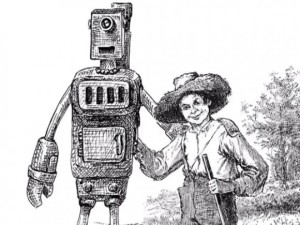
Image courtesy of Wikipedia
The things you read about in academia…
As part of my job, I have access to the University of Minnesota library system and all its digital subscriptions to academic research journals. Mainly I use this library to keep up with what’s latest in the field of plant cell biology, but it does let you stumble across stuff in other fields sometimes.
In 2005, LeiLane Nishime of Sonoma State University published an article in Cinema Journal called “The Mulatto Cyborg: Imagining a Multiracial Future.” I wish I could share this article with you, but I’m going to have to go over the gist of it instead. Nishime makes the argument that we use science fiction to tell stories about social issues in our own real life. Since it’s at one step remove (we’re talking about space aliens, not humans), writers can be more daring than if the story was set in the real world. So far, so good. Anybody who’s seen that infamous Star Trek episode where the people are black on one side and white on the other side … yep. We sure use science fiction to explore our own issues.
The second part of Nishime’s argument is this: if robots are our science-fictiony slaves in the future, then cyborgs are mulattoes.
Okay. Let’s just never mind that a union between Data and Tasha Yar is not where cyborgs come from, and examine her argument a little more closely. She says that movies deal with these mulatto cyborgs in one of three ways: they’re bad, good, or truly cyborgean. Bad cyborgs are more roboty and want to destroy all humans (like the Terminator). Good cyborgs have a stronger human side and want to become human. And the truly cyborgean cyborgs come to terms with their half-and-half nature and are not really either.
I’m curious what Nishime would have to say about Inspector Gadget.
There’s just one other problem with this paper. Robots with high-quality silicone skin aren’t cyborgs. Nishime argues that Bishop from Aliens and that little kid from A.I. are good cyborgs who are trying to become more human. But they’re robots. Whatever these characters are made out of, the other characters treat them like 100% robot, and there’s nothing borderline or half-and-half about them. That little kid is a robot trying to be a human.
And that’s my nerd rant for the day.
If you want to try to get your hands on “The Mulatto Cyborg: Imagining a Multiracial Future,” here is a link to Cinema Journal’s website.




